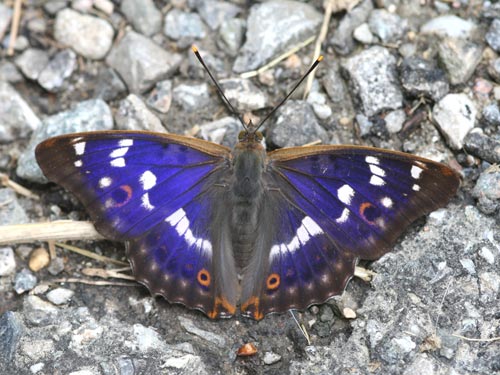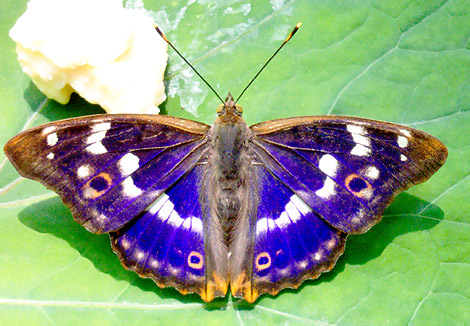Apatura ilia
Little Purple Emperor
The Little Purple Emperor ( Apatura ilia ) is a butterfly ( butterfly ) of the family Nymphalidae ( Nymphalidae ). He is sometimes referred to as aspen Schillerfalter.
- 6.1 Notes and references
- 6.2 Literature
Description
The Little Purple Emperor resembles the Great Purple Emperor and the occurring in Southeast Europe Apatura metis. On the upper wing surface, all three species have iridescent structural colors. The Little Purple Emperor reaches a wingspan of 55 to 60 millimeters. The difference in size to the Great Purple Emperor is so low that it possibly will notice when the animals are sitting next to each other. The main distinguishing feature is the coloring and patterning of the wing undersides. The white wedge on the hindwing underside is the Grand Schillerfalter lots of contrast, while it is drawn only blurred the little purple emperor. The total has sub-pages at the Great Purple Emperor a strong contrasting maroon and white coloring, the little purple emperor is, however, rather washed out with a yellow-brown tint. At the outer edge of the front wing top of the Small Purple Emperor wearing a big red ring that is missing the Great Purple Emperor. While the little ones Schillerfalter the tip of the sensor bulb is yellow-brown at least a quarter relates to this at the Great Purple Emperor at best the outermost sensor tip. The forewings of the Little Schiller moth are proportional shorter and less pointed to run. It occurs in two morphs: the Rotschillerform f clytie and the Blue Schiller form f ilia. A Rotschillerform there are not at the Great Purple Emperor. Both types often come together before on the same locations and sometimes sit very close to each other when they absorb minerals in puddles or mud.
Similar Species
- Great Purple Emperor ( Apatura iris ) (Linnaeus, 1758)
- Apatura metis ( Freyer, 1829)
Flight time
The Little Purple Emperor flies in one or two generations from late May to July and from July or August to September. In Germany a second generation is formed only under very favorable climatic conditions.
Habitat
This habitat of the Little Schiller Falters include clearings, glades and drawing paths in deciduous forests, the forage plants grow on the edges, but there are also wooded river valleys, especially the riverside with occurrence of the white willow Salix alba.
Way of life
After mating, the females lay the eggs on the leaf surface of the food plant. The freshly deposited eggs are greyish and take shortly after the color of the aspen leaf on. The caterpillars are very difficult to find due to their cryptic to. When oviposition play recently, black poplar hybrids and balsam poplar hybrids have become key. The assessment, however, that the cultivation of non-native, schnellwüchsigeren hybrid poplars would lead to a Artgefährdung, the females laying eggs not distinguish those of native species, the caterpillars, however, would not be able to eat the thicker and tougher leaves, shall, in accordance Ebert not to. " Black poplars and Canadian hybrid poplars do not differ in the mechanical properties of the sheets. Even the balsam poplar hybrids that actually have leathery thick leaves, not only is plentiful, but are, at least to a certain degree, also caterpillars as food. "
Among the food plants of the caterpillars include:
- Quaking Aspen (Populus tremula )
- White poplar (Populus alba)
- Black poplar (Populus nigra)
- Canadian hybrid poplar (Populus x canadensis)
- Ontario poplar (Populus x gileadensis )
- Goat Willow (Salix caprea )
Outside Central Europe added:
- White willow (Salix alba)
- Salix atrocinerea ( Northern Spain)
For overwintering caterpillars take to the gray color of the bark and hide in rough bark crevices. Weidemann also reported wintering at the branch tips, where the caterpillars cling to the second or third bud. However, the proportion of dried " buds over-wintering " is quite high.
The males of the Small Schiller moth are found to strong-smelling substances. These include excrement ( dog waste, horse manure ) or carrion, from which he draws the means needed to achieve the fertility minerals. In contrast, the females search for carbohydrate-containing food, they can be the " honeydew " of aphids find or overripe fruit. Can you attract the kind with a strong smelling cheese bait.
It is threatened by the deforestation of riparian forests and woody plants, the Ausholzung of poplars and willows along forest paths and inner forest fringes, probably sometimes overpopulations caterpillar- eating birds (especially tits ).
Dissemination
The Little Purple Emperor is widespread in Northern Portugal (Minho ), northern Spain ( Cantabrian Mountains, and the provinces of Huesca and Catalonia ). Furthermore, from the Pyrenees to Latvia, in the Balkans, in northwestern Greece. The species is absent in the western North Germany, Poland, Fennoscandia, Britain and southern Italy. In the vertical distribution it is found 300 to 1300 meters.
- Red List BRD: 3
- Red List of Baden- Württemberg: 3
- Red List Saxony: 3









